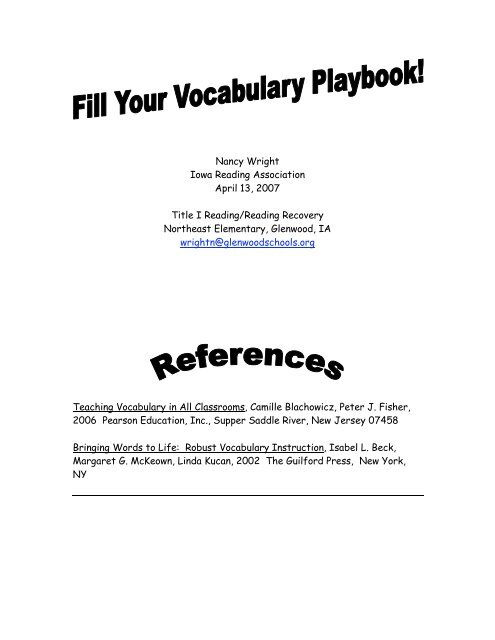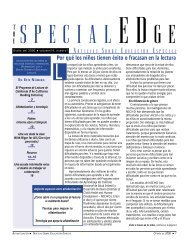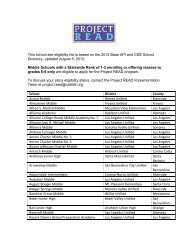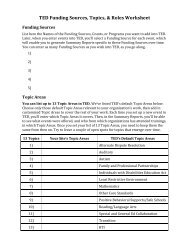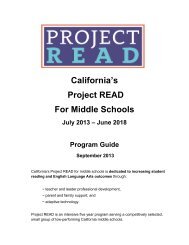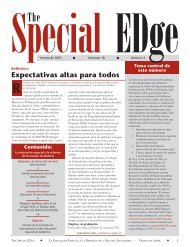Fill Your Vocabulary Playbook - CalSTAT
Fill Your Vocabulary Playbook - CalSTAT
Fill Your Vocabulary Playbook - CalSTAT
Create successful ePaper yourself
Turn your PDF publications into a flip-book with our unique Google optimized e-Paper software.
Nancy WrightIowa Reading AssociationApril 13, 2007Title I Reading/Reading RecoveryNortheast Elementary, Glenwood, IAwrightn@glenwoodschools.orgTeaching <strong>Vocabulary</strong> in All Classrooms, Camille Blachowicz, Peter J. Fisher,2006 Pearson Education, Inc., Supper Saddle River, New Jersey 07458Bringing Words to Life: Robust <strong>Vocabulary</strong> Instruction, Isabel L. Beck,Margaret G. McKeown, Linda Kucan, 2002 The Guilford Press, New York,NY
<strong>Vocabulary</strong> learning is “problem solving”• Preteaching of vocabulary does not always affect comprehension.• We can comprehend stories fairly well without knowing every word.• Lack of word knowledge is overcome with help from the learner’s knowledge ofsyntax, grammar, stories, concepts, and the world in general.Good instruction builds vocabulary!At-risk students come to school knowing fewer words, including school-type words. Theymay also have a limited network of meaning for familiar words. Both deficits make itdifficult for these students to make connections of meaning. Good instruction CAN make adifference for these at-risk learners.FOUR GUIDELINES OF EFFECTIVE VOCABULARY INSTRUCTION1. Teacher builds a word-rich environment.2. Teacher helps students develop as independent work learners.3. Teacher uses instructional strategies that each vocabulary effectively and modelgood word-learning behaviors.4. Teacher uses assessment that matches the goal of instruction.CHOOSING WORDS TO TEACH:Isabel L. Beck, Margaret G. McKeown, Linda Kucan, 2002Consider that words in the language have different levels of utility.• Tier 1 words: Familiar words used in conversation – clock,baby, happy These wordsrarely require instruction in school.• Tier 2 words: Most often used in written language – coincidence, absurd,industrious Instruction in these words can add productively to an individual’slanguage ability.• Tier 3 words: Specialized vocabulary – such as math terms, science, geography(isotope, lathe, peninsula) Frequency of use is low, limited to specific domainsIdentifying Tier Two Words in textsTier Two wordsStudents’ likely expressionsmerchantsalesperson or clerkrequiredhave totendtake care ofmaintainkeep goingperformeddidfortunateluckybenevolentkindIsabel L. Beck, Margaret G. McKeown, Linda Kucan, 2002
SOME CRITERIA FOR IDENTIFYING TIER TWO WORDS• Importance and utility: Words that are characteristic of mature language users andappear frequently across a variety of domains.• Instructions potential: Words that can be worked with in a variety of ways so thatstudents can build rich representations of them and of their connections to otherwords and concepts.• Conceptual understanding: Words for which students understand the generalconcept but provide precision and specificity in describing the concept.Blachowicz and Fisher state: . . . the effective vocabulary teacher presents newvocabulary in ways that model good learning. . . having learners take an active role inconstructing a network of meaning for a word is critical.Learn words in contextLearning to sew: thread, needle, selvage, pattern, dartLearning to play baseball: hit, run, base, flyLearn words by answering questions that ask students to evaluate different features of wordmeaning (Beck & McKeown, 1983).“Would a recluse enjoy parties?”Careful selection is the teacher’s responsibility: Which words will receive focus?• Comprehension words – essential to understanding the selection (Rebel would becritical to understanding Civil War selection)• Useful words – not critical to understand a particular selection, but high-utility forlater use (homesick)• Generative words – have parts or morphemes that lead to further word learning(prefix “re-“)• Academic words – cause lots of trouble for at-risk learners or second-languagelearners (in contrast, however, analyze)Learn words by making meanings and relationships visible – semantic webs, maps, organizers.Learn words by making it personal for the student – relate words to past experiences; link to priorknowledge; act-out word meaning. Create a mnemonic or image to personalize meaning.Learn words by trying them out – students need opportunities to use words in writing andconversation with feedback from the teacher.
Learn words through word-play: poetry, riddles, games, activities1. VOCABULARY TEACHING WITH TEXT• Start with a picture walk or semantic map• Anticipation – choose 8 to 10 words to understand the text• Pre-reading – use word meanings to set theme• Point of contact teaching – just tell the meaning (especially with very young children)• Consolidation – State the story’s main idea, remember the word “determined”• Sort words by category (types of animals, known/unknown words, types oftransportation) WORDS THEIR WAY (Fountas and Pinnell)• Give examples: “exquisite” – The dinner is exquisite.In this story, “exquisite” means . . . .The story said, . . . . . .What else might be exquisite?What do you think of when you hear the word exquisite?2. TEACHING VOCABULARY WITH ACTIVE INVOLVEMENT• Word of the day (students can generate words from their reading)• Word web• Word consciousness -- locate “size” words in fairy tales, then rank the words on acontinuum by size: tiny, gigantic, puny, wee, huge• Word Play – words you like to hear, say, use (dawdle, enormous, linger,)• Interactive classroom talk: Teach says “The door is open” -- “The door is ajar”.“Line up too slowly” -- dawdle• Act out words – eager, sadly, gusto, morose, scamper, crawled• Four squareMammalDefinitionExamples (fox, dog, cat, horse)Non-examples (fish, frog, bird)• Content <strong>Vocabulary</strong> Word Wall (such as PWIM or <strong>Vocabulary</strong> Visits) These canbe used all year to help students when writing.Butterflies and moths: A – antennae, C – caterpillar, W – wings• Making distinctionsHow is storm like hurricane? How is it different?How is violet like purple?How is dry like arid?• A continuum of wordsPretty to ugly Tall to short Day to night• Word Study – rootso Tri – triangle, tricycleo Oct – octagon, octopus
o Bene Malbenefitmalcontentbenevolent malevolentbenediction malediction• Venn Diagrams – compare and contrast (i.e. Pets/Mammals)• Word Wizard – Students pick “school word” such as “identify”Stick up a post-it note each time the students use it3. VOCABULARY VISITS• Teacher assembles thematic text sets with related vocabulary (Weather –storms, hurricane, thunder, lightning, damp).• Create visual chart of what can be seen, heard, smelled, tasted if you were on anactual field trip – What do you see? (lightning, flash, storm) What do you hear?(thunder, crash, boom) What can you feel? (wet, rain, soggy)• Use a picture poster and label with sticky notes – use the words over a period oftime in many ways (sentence writing, listen for the words in a story, sort wordsby category, add new words)• Save the <strong>Vocabulary</strong> Visit poster for future reference4. STRATEGY FOR CONTEXT-USE LESSONMake a transparency of a passage and omit a contextually explained word.Direct students to• LOOK. Before, at, and after the word.• REASON. Connect what they know with what the author has written.• PREDICT A POSSIBLE MEANING.• RESOLVE OR REDO. Decide if they know enough or should stop.Discuss—discussion is critical.Reveal the author’s word choice.Discuss further. Use references to elaborate.5. VOCABULARY SELF-SELECTION STRATEGY• Students bring two words to class that they have found in reading, listening, etc.• Each student presents words to the group.• The group votes on five to eight words to be learned for the week.• The teacher leads a discussion to clarify, elaborate, and extend word meanings.Discussion is critical.• Students enter their words into personal word logs and create some sort ofmemory and meaning aid (chart, diagram, picture, mnemonic, etc.).• Students may create writing assignments, activities, games, and tests forpractice.6. DRAMA – WORD PLAYS• Choose a short list of vocabulary words (three to five) from the selection thatgives an impression of the setting, characters, problem/goal, actions, resolution,
and feeling. Place the words on index cards. Make a set of cards for each groupof students.• Give each team a set, and ask them to construct a 3-minute skit based on thevocabulary. As they plan, circulate to provide information and clarification asneeded.• Share the skits. Compare and contrast across student skits to look forsimilarities and differences.• Read the selection to compare the author’s choices with student’s choices.• After reading, refine vocabulary. Go back to the selection to clarify meaning oruse reference words.• Use the words in further oral or written work.7. KNOWLEDGE RATING – STUDENT SELF-EVALUATION• From the selection, choose a list of vocabulary words that cluster in some way.Place the list on the chalkboard or overhead projector.• Ask students to copy the list and to rate their knowledge of the words as: 1—Don’t know anything. 2—I’ve heard or seen this word but I’m not sure what itmeans. 3—I know this word well enough to use it or define it. Students mayshare their knowledge as they work.• Use the ratings for group discussion. Lead students to make appropriatepredicitions about the selection.• Read the selection, watching for the vocabulary.• After reading, have students rerate themselves. Then refine vocabulary. Goback to the selection to clarify words or use reference books.• Use the words in further oral or written work. Students may use knowledgerating as an organizer for studying.8. CHARACTER MAPPINGTeacher leads students in understanding the author’s character development as thegroup reads from a core book.• After reading the first few chapters, the teacher asks the students to suggestsome adjectives that describe one of the main characters. Students useincidents in the story to support their word choice.• In subsequent lessons, students add more characteristics and evidence thatsupports the actions of the character.9. LITERATURE UNITS IN PRIMARY GRADES – ABC BOOKSTeacher selects topic or theme – can be a culminating activity for a unit.• Each child is given one letter of the alphabet, and selects a word from the unitto define.• Definition can be pictures, words, or both.• Variation – give a group of students two or three letters to make for the ABCbook.• Assemble student pages into a classroom ABC Book.(See http://www.readwritethink.org/ for examples)
10. COOPERATIVE LITERATURE DISCUSSION GROUPS<strong>Vocabulary</strong> is selected by a student in the group, assigned by the teacher, or acombination of both.• Group roles: discussion director is responsible for preparing questions to leadthe group’s discussion; vocabulary researcher chooses four to six words thatwill be unfamiliar to the group; literary leader selects a passage for oral readingthat might illustrate some language the teacher emphasizes; secretary-checkersees that group members come prepared, keeps track of time andmaterials/work.• Day 1 – Form groups, distribute books and journals. Explain procedures. Eachgroup decides on the number of pages to read for each class to complete thebook in four sessions. Each person in the group is responsible for taking adifferent role on each of the four days.• Days 2, 3, and 4: Each group member is responsible for coming to class havingcompleted the reading and prepared to fulfill his/her role for the day.Procedures for 20 to 30 minute sessions: discussion leader reads a summary ofthe action. All group members read their reactions. Each member completesthe assigned daily task, beginning with the discussion leader, vocabularyresearcher, literary leader, and secretary-checker. Group members share theirpredictions for the next reading. Complete and discuss self- and group-processevaluations and assign roles for the next day.• Day 5: Same as days 2, 3, and 4. Additionally, each group needs to develop aplan for sharing its novel with the class on day 6.• Day 6: Each group shares its novel with the whole class.11. DRAMATIZING IDIOMS(Phrases or expressions that have meanings different from the literal.)• Have students in groups identify idioms in recent stories they have read. (paythrough the nose; don’t pull my leg)• Students select an idiom they think might be easy to act out.• Students write a short episode or skit in which the literal meaning of the idiomoccurs. For example, a person selling shoes might pull someone’s leg when tryingto get off a tight-fitting shoe.• Other students in the class try to guess what idiom is being acted out by thegroup.Amelia Bedelia stories are great sources for idioms.


